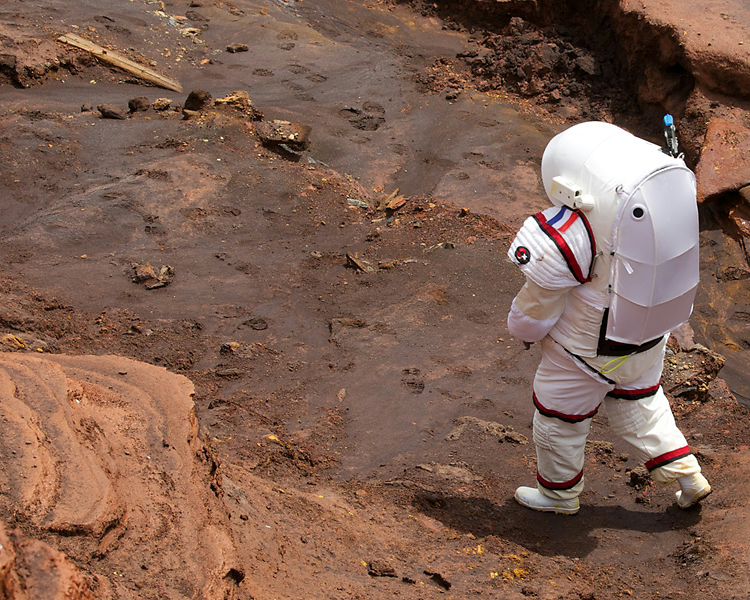Spacewalks on Earth – Project Moonwalk unites seven European partners, including Airbus, to develop and test technologies for future human missions to Mars.
Helping hand for astronauts
“I’m convinced that we will plant the European flag on Mars sooner or later,” says Víctor Parro, a microbiologist from the Center for Astrobiology, Madrid. Parro is a member of Moonwalk, an exciting project to simulate a manned mission to Mars.
With seven partners, including Airbus, Moonwalk is developing innovative technologies for cooperative human-robot space exploration. Astronauts equipped with an extravehicular suit are supported by a small rover. The project, funded by the European Commission, is working on a man-machine interface for efficient robot control using gestures.
“The role of Airbus in Project Moonwalk is to provide biomonitoring support so that we can incorporate technology in the suit that allows mission control to understand the physiological and psychological state of the astronaut,” says Michael McDowell, data scientist at Airbus Innovations (AGI).
Which way is up?
Project Moonwalk’s consortium is made up of Airbus, COMEX, LIQUIFER Systems Group (LSG), Space Application Services (SAS), NTNU Centre for Interdisciplinary Research in Space and Instituto Nacional de Técnica Aeroespacial.
“In low gravity, orientation is difficult. In a pressurised space suit your range of movement is also very restricted. How do astronauts know which way up is, for example? Or if they’re going to get stuck in a certain position? Reading data from movement sensors allows us to provide assistance and warnings where necessary,” explains Alistair Nottle from AGI’s Data Analysis & Interaction team in the UK.
A second development adopts the same sensors as the gesture controls. “By using a system integrated in the suit, we can detect if the astronaut is close to falling over. This happened a few times during the Apollo missions. When we receive an alarm, we can tell the astronaut to be careful and adjust position,” adds German engineer Peter Weiss, from the French company Comex, technical coordinator of the ‘pretend’ mission to Mars

Climbing the 'Martian' ramps
The Moonwalk simulations at Rio Tinto represent the first demonstration of collaboration between an astronaut and a gesture-controlled rover. Equipped with blades instead of wheels, the YEMO micro-rover has been developed by the German Research Center for Artificial Intelligence (DFKI).
Capable of carrying a 5 kg payload of collected samples, YEMO has been climbing the ‘Martian’ ramps at Rio Tinto, but will also be tested underwater off the coast of Marseilles as part of testing for future missions to the Moon.

From rover to rover
At Rio Tinto, scientific operations have included in-situ surveys with a portable Raman spectroscope, capable of detecting minerals and organic compounds. Samples were taken back to a planetary habitat simulator to be analysed by SOLID (Signs Of Life Detector).
“If we are able to send a mission like this to Mars, then we are convinced that we will detect remains of life if they are there,” says Víctor Parro.
While YEMO was negotiating the Rio Tinto landscape, on 29 April 2016, European Space Agency (ESA) astronaut Tim Peake successfully took remote control of the rover ‘Bridget’ in the UK, all the way from the International Space Station. This Airbus Defence and Space prototype rover is part of ESA's Meteron project that is preparing for future human-robotic missions to the Moon, Mars and other celestial bodies.
“Today, Mars. Tomorrow, the stars”
During the testing campaign, the Moonwalk consortium also invited children aged 6 to 14 to participate in the project, asking for suggestions for the first words to be spoken on Mars.
The winning sentence, by 7-year-old Guadalupe Maíz Apellániz from Spain was: “Today, Mars. Tomorrow, the stars”.

Diego Urbina, Project Moonwalk astronaut
A Colombian-Italian electronics engineer, Diego Urbina is simulating Mars by testing the Gandolfi 2 spacesuit and the extravehicular communications system with Alistair Nottle and Michael McDowell, from Airbus Innovations.

What is the human-machine interface?
It mimics several flight-like parameters, such as communications delay. One very important development is the possibility of having sensors on the body of the astronaut during spacewalks, when they are in the suit and working really hard. All of this information has to travel to Earth and it takes between 7 and 20 minutes to arrive.
How does the simulation work?
We connect the sensors developed by Airbus to our computer and then simulate the time that it takes the signals to get to Earth. From the Brussels Control Centre at Space Applications Services, mission controllers can look at the health of the astronaut and decide whether he can continue with the spacewalk, keeping in mind that this information arrives seven minutes ‘late’.
How long does it take to travel to Mars?
It’s a very long trip. It takes about eight months to go, and then you could either stay on the surface for around a month, or you would have to stay for more than a year. And then, of course, it takes another eight months to come back. There are many challenges to overcome, both in terms of the engineering required and surviving the hostile environment.
Manuel Ansede
